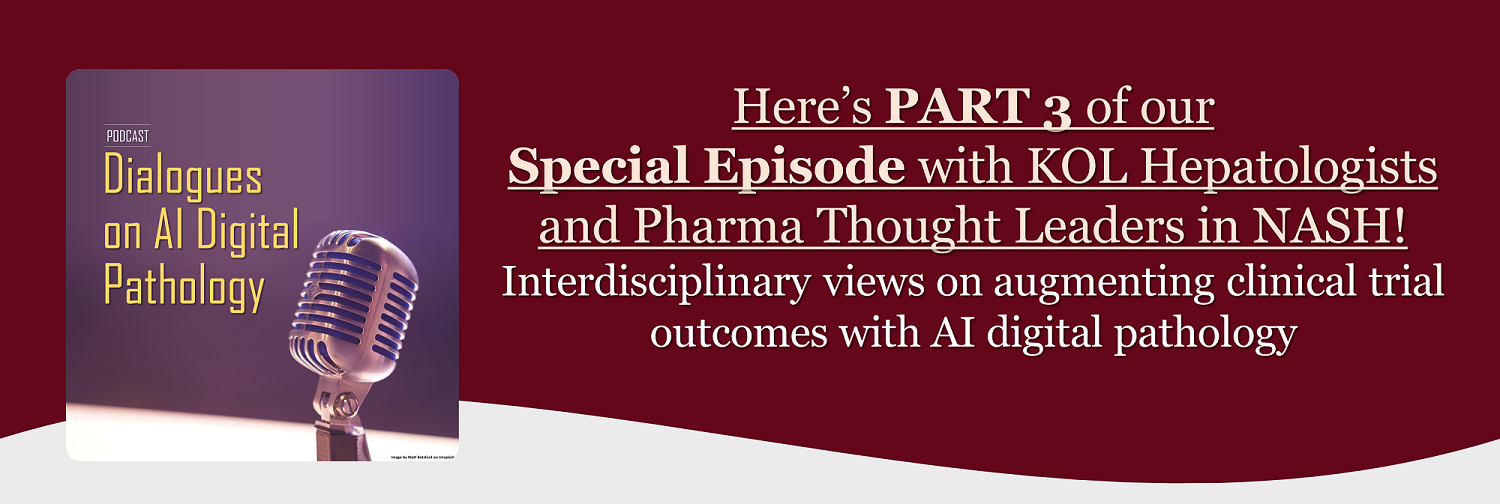We’re very excited to bring you another Two-Part Special Episode of Dialogues on AI Digital Pathology!
We’re bringing you Part 3, where our guests – KOL Hepatologists and Pharma Thought Leaders in NASH – respond to questions by Pharma companies and clinical investigators on how AI Digital Pathology (AI-DP) can augment clinical trial data and work alongside pathologists to detect granular information that could be pivotal for determining patient recruitment, staging and treatment responses.
This conversation will continue with Part 4 in mid-June 2021, so please do stay tuned!

Special Episode (PART 3) - Conversation with KOL Liver Pathologist
KOL Hepatologists
Prof Stephen Harrison,
Medical Director, Pinnacle Clinical Research (USA)
Prof Vlad Ratziu,
Professor of Hepatology, Sorbonne University and Pitié-Salpêtrière Hospital (France)
Pharma Thought Leaders in NASH
Dr. Judith Ertle,
Senior Clinical Program Lead NASH, Boehringer Ingelheim (Germany)
Dr. Karin Conde-Knape,
Senior Vice President Global Drug Discovery, Novo Nordisk (Denmark)
Ms. Kitty Yale,
EVP and Chief Development Officer, Akero Therapeutics (USA)
Moderator
Dr. Nikolai Naoumov, Senior Adviser for Clinical Research and Drug Development in Liver Diseases,Novartis Pharma AG (Switzerland)
Key Takeaways from the KOLs in this Special Episode (Part 3)
- The innovation and qualities that AI Digital Pathology (AI-DP) brings to drug development can be described as a disruptive technology as it expands the knowledge of NASH pathobiology, introduces standardization and reproducibility on a fully quantitative scale, allows to better define a dose-response to compounds with different Mechanism of Action (MoA) and regression or progression of NASH disease. In addition, AI-DP has the potential to stabilize placebo response rates and provide a better understanding of how the drugs are working in dose-dependent responses.
- AI digital pathology brings two key novelties: firstly, it provides better understanding of liver injury, both for the clinical practice and for clinical trials with a robust and reproducible reading of NASH features and avoids the intra- and inter-observer variabilities; secondly, at a discovery level, AI-DP uncovers new parameters and greater details that cannot be detected by the human eye.
- The use of AI-DP is not intended to replace routine pathology review of liver biopsies. It augments the information from conventional pathology by providing a standardised reading, helps reduce the rate of screen-failures as well as ensuring a more precise, granular quantitation of treatment response. AI-DP will be particularly valuable in clinical trials involving patients with cirrhotic NASH (as they have a wide range of collagen deposition) by providing quantitative understanding of collagen dynamics within the F4 stage and accurate assessment of treatment efficacy.
- In repeated screen failure situations due to inter-observer variabilities, AI-DP can also increase the sensitivity in detecting changes in the early fibrosis stages (between F1 to F3) and is critical for producing an integrative assessment combining liver histology results with other investigations to guide patients’ eligibility for clinical trials.
- To-date, the application of AI-DP has revealed fibrosis reduction in response to several investigational drugs with different MoA which have not reached >1 stage fibrosis improvement by the current NASH-CRN scoring system. More AI data are needed to show how different treatments are impacting liver histology, comparison between doses, fibrosis dynamics in F4 cirrhosis NASH and effect of different treatment durations. To use AI-DP routinely along with conventional assessment of liver histology, it is also necessary to define the variability of AI readings, reproducibility between different laboratories’ staining and establish the differences in AI algorithms by different providers.
- FDA is data-driven and the accumulated data from the use of AI-DP in various NASH clinical trials will be welcomed by the FDA and other regulators. In Phase 2 trials - the greater granularity and full quantification of novel parameters, as secondary or exploratory end-points, if congruent with routine histology will be useful in gaining confidence in the MoA, dose selection, show differences between active arms and placebo, thus providing greater confidence in the effects of the investigational drug. At present, for Phase 3 and for approval, the regulators require the traditional histological surrogate end-points or hard clinical outcomes and for the regulators to consider implementing AI-DP would depend on further demonstration of AI-DP endpoints’ close association with clinical outcomes.
大咖对话第3期(音频):Suneil Hosmane博士-AI数字病理学的
对话大咖对话第4期(音频):诺华Nikolai Naoumov博士-AI数字病理学的对话
大咖对话「特别续集 part1」(音频):对话肝脏病理KOL
大咖对话「特别续集 part2」(音频):对话肝脏病理KOL